Posts tagged "music"
← All tags
December 6, 2023
I've been keeping a 'creative notebook' for the better part of the year. I was trying to learn many things at once, and wanted to help make sense of it.
Here are some things I wrote in my creative notebook about the three main things I worked on this year in my practice: taking photos, playing alto sax, and learning darkroom as well as inkjet printing.
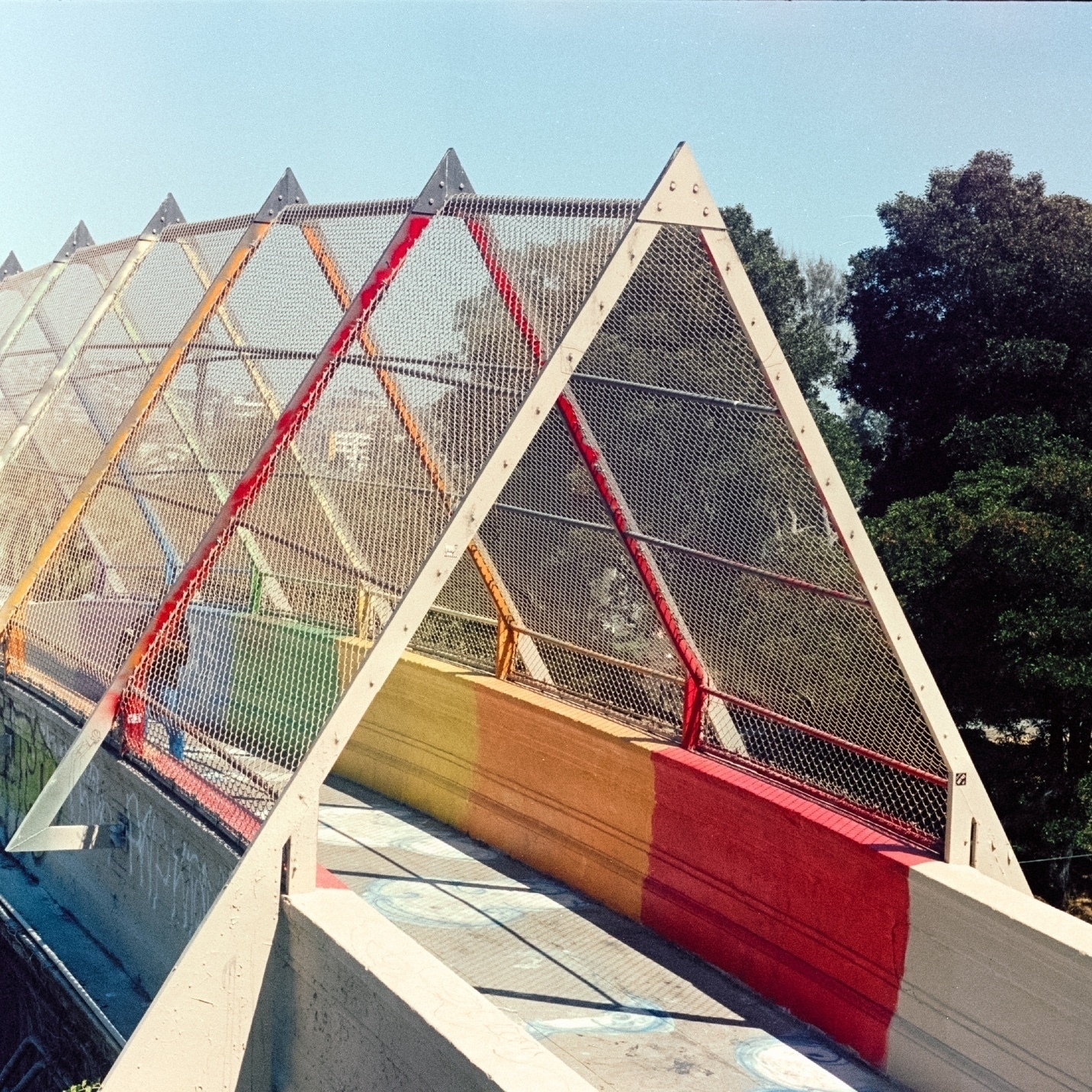
Bridge at Dolores Park, San Francisco. (Leica M3, Kodak 250D).
Learning film photography
#
What I set out to learn about film photography:
#
- shoot ten thousand photos in 2023 on color, black and white and slides. (I got to 7000, and did a lot of color and black and white, but only a few slides). I wanted to do this as I had not been taking photos on film for more than a decade. I figured the more photos I took, the more I would learn.
- learn to load film from 100ft bulk rolls (done: I load black and white, as well as slide film and motion picture film regularly)
- learn to load film in film dev tank (done: the hardest thing to do was not be so impatient. That led to many kinks and crimping in the film, early on)
- learn to develop black and white, C-41 (color) and ECN-2 (motion picture film) (done: I don't enjoy the ECN-2, but can easily do the rest)
- how to scan 35mm and medium format film using a Fuji Frontier as well as home scanners (done: it's a regular part of my creative workflow now)
What I learned about film photography
#
- Things that seem intimidating are quickly learned, once you try
- Some things feel complex and overwhelming if you try to intellectualize things in your brain. Getting motivated to just do it is more important than thinking about how to do them perfectly or expertly
- Mistakes happen, and we can learn from them but mistakes that arise from being careless (for example, if I try to develop 5 rolls of film at once but I'm exhausted before I begin, I am likely to make cascading mistakes) can be avoided by being mindful of my current state
- Get rested before trying new things, especially if it is a difficult thing or something I have 'failed' at previously
- Don't forget to have fun

Charles Unger of the Charles Unger Experience trying out my Yamaha alto sax. (Minolta Hi-Matic 7S II, Kodak T-Max 400, Perceptol 1:2).
What I set out to do with music:
#
- learn to improvise to play jazz standards
- spend more time practicing my alto sax every week
- be able to easily play the high E, F and G
I think I got to do all of that, and have greatly improved my improv skills but I still need to work on it.
What I learned about music
#
- My classical music grounding has given me many skills: I can play almost anything written, I can still sightread extremely well, I can play 'in time' easily
- However, I need to keep working on improvisation so it feels less like a mystery, and more like second nature
- To do this, I need to keep practicing
- Go back to basics: work on all scales and chords
- Practice all the jazz standards
- Spend as much time out there with working musicians as I can: I notice that if I do, even if I'm just messing around, I pick up new skills exponentially, as if by osmosis
- Things that are hard on my own at home: playing the high F on the alto sax, comes almost instantly when I'm in a music studio environment with other musicians and just 'fiddling'
- Same as with photography, don't intellectualize too much: trust yourself to reach a note or be able to find the right ones, and just do it
Learning to print (darkroom and inkjet)
#
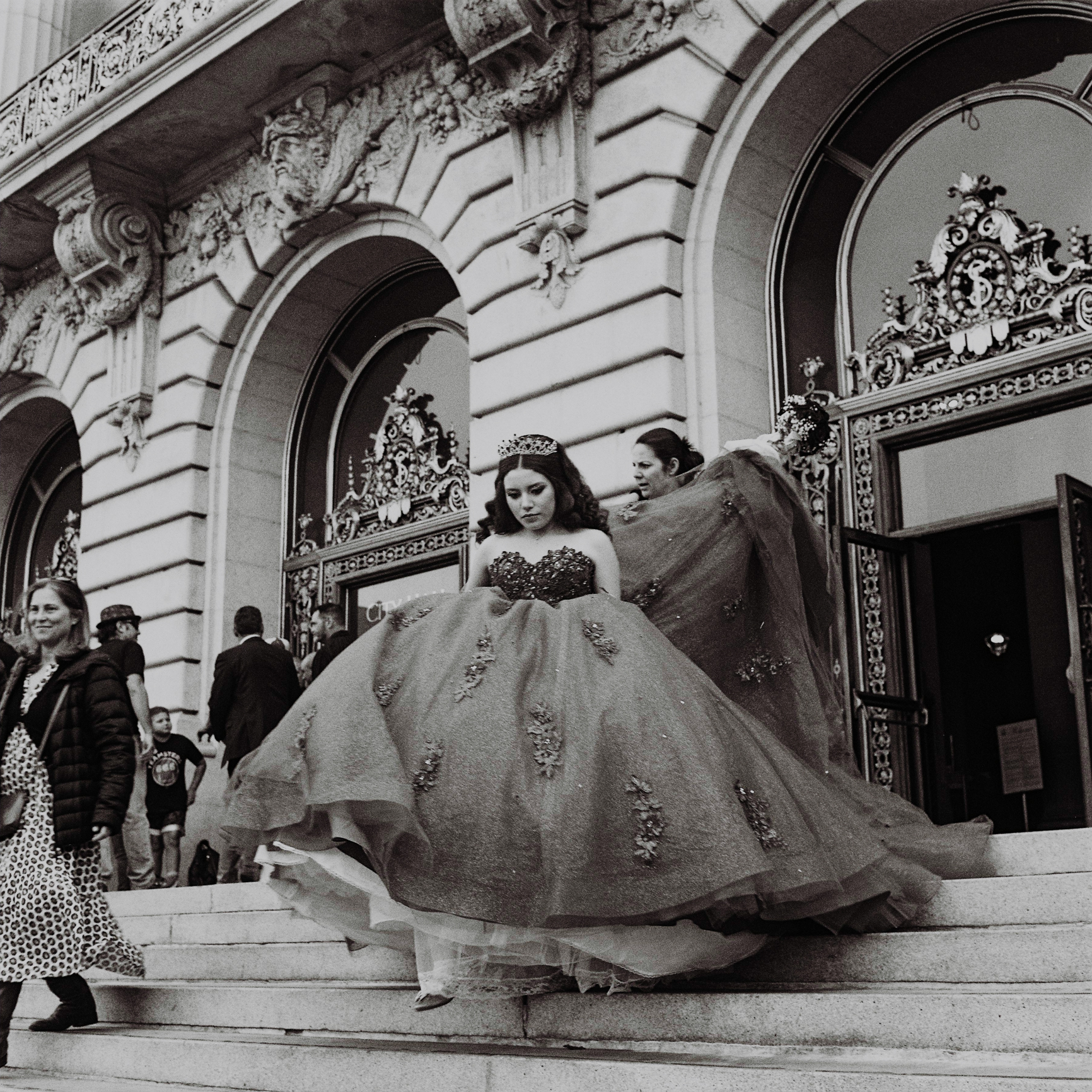
Bride at San Francisco City Hall. (Yashica Mat 124G, Kodak T-Max 400, Rodinal 1:50)
What I set out to do with printing:
#
- learn how to print photos using different types of paper on an Epson SureColor P7570
- print inkjet color and black and white photos
- learn how to print black and white photos in a darkroom
- learn how to print color photos in a darkroom
I got to do all that! And really love this more than I thought I would.
What I learned about printing:
#
- Don't get nervous about not knowing or remembering all the things
- The more darkroom time I get, the more naturally it will come to me
- I've already exceeded my own expectations by being able to actually produce an image (for both black and white, and color): doing something almost entirely in the dark is less anxiety-inducing than when I started
- Practice as much as you can
July 29, 2023
Early pandemic, I decided to reconnect with a part of my life that was very important to me: music. I played music, specifically piano, clarinet, trumpet, and other orchestral instruments, for most of my life. Then I stopped. Startup brain worms got to me. I did nothing but work for many years.
The best digital piano in my budget that available at the time was the Yamaha P-125. All I wanted was a piano that was white, had weighted keys, had 88 keys, and that I could use with headphones.
I had a lot of fun with it, but the one problem I had was that I don't really like how it sounds.
There's a particular range of keys (I think in E4 to G4) that sound, to my ears, a bit weird and digital. When I play them together they smoosh into each other and it is noticeable enough that I recoil, every single time.
Instead of getting a new piano, I decided to try to tweak it somehow.
Here's what I did.
- Get a printer cable and connect the P-125 from the back (near the power cord) to your computer's USB / USB adapter
- Install the USB-Midi Driver so that I can use the P-125 as a Midi keyboard on my Mac
- Install Pianoteq
- Get decent headphones, I have the Audio-Technica ATH-M50x (you can get them used, for a third of list price, on audiophile forums or subreddits)
The only thing slightly confusing about all this was how to activate the keyboard as a digital piano. Turns out, you need to press the metronome and rhythm key AS WELL AS the C5 key at the same time, in order to switch the audio output to the computer. You know that you've succeed at this when the piano says 'Off' in a slightly robotic voice. This means that the piano will now not output sound on the piano. You can now decide how to hear the music. On Pianoteq on my Mac, I either define the output as 'my nice speakers' if I want to hear the piano through my nice speakers; or 'digital piano' (then I plug in my headphones to the piano directly) if I want to listen through there. I use the headphones when I don't want to disturb my neighbors, like when I'm playing late at night.
You'll know this is working (both on speakers and headphones) when you change the instrument on Pianoteq to something like 'vibraphone' and you can hear that the output.. sounds like a vibraphone. Personally, I really like the Steinway jazz and Grotian instruments. For those who have piano tuning interests, the pro version lets you tune each note. For someone like me who just wants to play a digital piano and have it sound better, the stage version is sufficient.
Pianoteq is not cheap, but it is one of the best ones and it's what I like most.
Next up, I'd like to learn Logic Pro and learn to arrange and record.
February 20, 2023

Photo taken on Minolta Hi-Matic 7S II, Fuji Superia 400, developed and scanned at Underdog Film Lab, Oakland
Another photo from another concert I walked to from home.
We were invited to attend a gala concert for the New Century Chamber Orchestra. I'd gone to a show some time ago, really liked it, wrote about it, and met some of the folks involved through that.
It was our first time attending a high society event in San Francisco. There was wonderful music. The multiple Grammy-winning San Francisco Girls Chorus sang a few select pieces, and we were also treated to the 'dark, velvety' operatic voice of Nikola Printz.
Since the theme of the evening was 'Out of the Woods', there were also fairies. Naturally. I took a photo of one of them here.
Invalid DateTime
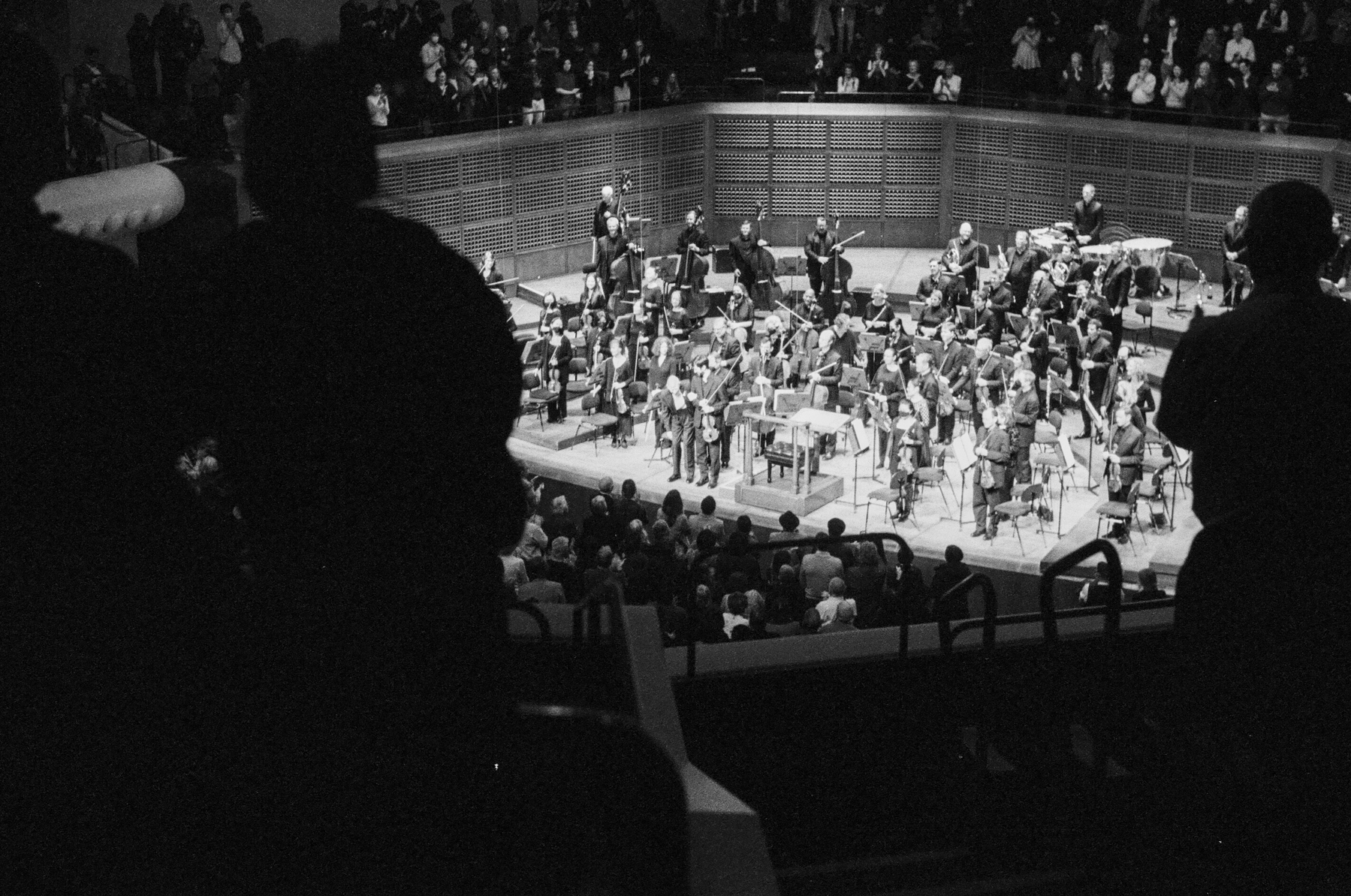
Photo taken on Leica M3, 50mm Summilux, Kodak T-Max P3200, developed and scanned by Underdog Film Lab, Oakland.
One of the joys of living in downtown San Francisco is how I can get to many cultural events with a 10 minute walk. Some nights it's jazz at SFJazz, others it's at the opera or symphony. Many rock and punk (even Balkan music!) shows within walking or transit distance, too! Even though many artists have been priced out of San Francisco, many cornerstone and higher prestige shows still remain here at the downtown venues. I do find myself popping over to Oakland for more hiphop and even folk music, though. That stuff is barely in San Francisco anymore.
I brought my Leica M3 and 50mm Summilux to the SF Symphony to watch Herbert Blomstedt conduct Dvořák’s Eighth Symphony. With high ISO film (T-Max P3200) of course. The Leica was very silent, though of course I didn't take photos while the orchestra was playing. It was also my first time shooting T-Max P3200 indoors in a dim setting. I like this photo, and want to keep documenting the music I go to see.
January 31, 2023
Maybe some day, I'll think of the years between 2009 and 2019 as a lost decade. It was a decade of development, when I came of age, when I left home, when I made my home in so many different places in the world, where I tried on different ways of being, as if they were seasonal coats, or swimwear.
Things are different now.
When I was least expecting it, king tides subsided and became gentle lakes. The weather is rarely frosty or humid, it's mostly even-tempered, and cool. I have time to sleep, exercise, meditate, and eat well: I am no longer scurrying from here to there. I know how lucky I am.
I got to recover from a chronic illness that not only took away my physical abilities for a long while, I also got to bounce back mentally from it. From insomniac mania, I now have a well-rested, even-keeled, decently-paced life (and personality). When I think back to those years, to 2012 and right after especially, I wonder how anyone ever kept up with me. I barely did. (Autoimmune diseases are a bitch. Don't let anyone tell you otherwise.)
I have work that is engaging, challenging, and evenly paced. I have the weekends to discover and explore. Surprising to everyone, especially to myself, my new hobbies are fun, slow and old: birding. Cycling slowly. Walking slowly. Hiking. Being in nature. If I'm optimizing for anything (throwback to my startup days!), that's it.
So many weekends spent around the Bay Area wandering about with friends and people I love. Sometimes I look at birds. Sometimes I look at fungi. Many times, I am just happy and so damned pleased to be out and about, and alive.
In line with the theme of 'finding joy in things I have always loved', like playing my piano, saxophone, clarinet for fun, I started picking up my camera again. Over there, on my microblog, I'm documenting all the ways in which my brain gets to have fun. I've forgotten how nice it is to just make things, tell stories, and do things for fun.
I'm done with the hustle.
The hustle that I want to spend time and energy on is the one that's about nourishing my soul. I'm working on some long term writing and photography projects. While it's tempting to think of 2009 - 2019 as the lost years in which I did not do very much creatively, I think it's given me the experiences and time to really become the kind of artist that I want to be. In recovering from chronic illness and hustle-related illnesses, my mind is now clearer than before: I have the headspace now to work and make things the way I want.
It's still too early to share what I'm working on, but know that things I do in this space will always have something to do with one or all of the following: immigrants, California, India, Southeast Asia, food, culture, festivals, climate, nature, mushrooms, birds, queerness, bicycles, music, and maybe more. Those are all of the keywords to my life, these are all of the things that keep me going. Until then, snippets of my creative brain can be found at the microblog, and sometimes also on Mastodon (especially at the #FilmIsNotDead hashtag that I sometimes use).
So instead of focusing on status, success, money, or hustle and grind culture, I'm going to explore all the ways in which I can immerse myself deeply in all of the things that I love, some or all of them at once. And I feel incredibly lucky to have the opportunity to do this.
January 30, 2023
I was having a horrible day in August 2020, feeling shut in and defeated. There was no Covid-19 vaccine yet, and we had been sheltering in place in our tiny studio apartment for around 6 months by that time. Going out for a walk with my camera was something that helped me find the little joys of life.
I hadn't used my Leica in a while, and this was one of the moments that brought a smile to my face. I'm glad I managed to stand there and hear them play for a few minutes. It lifted my spirits. I'm also glad that I have a photograph to remind me of that time.
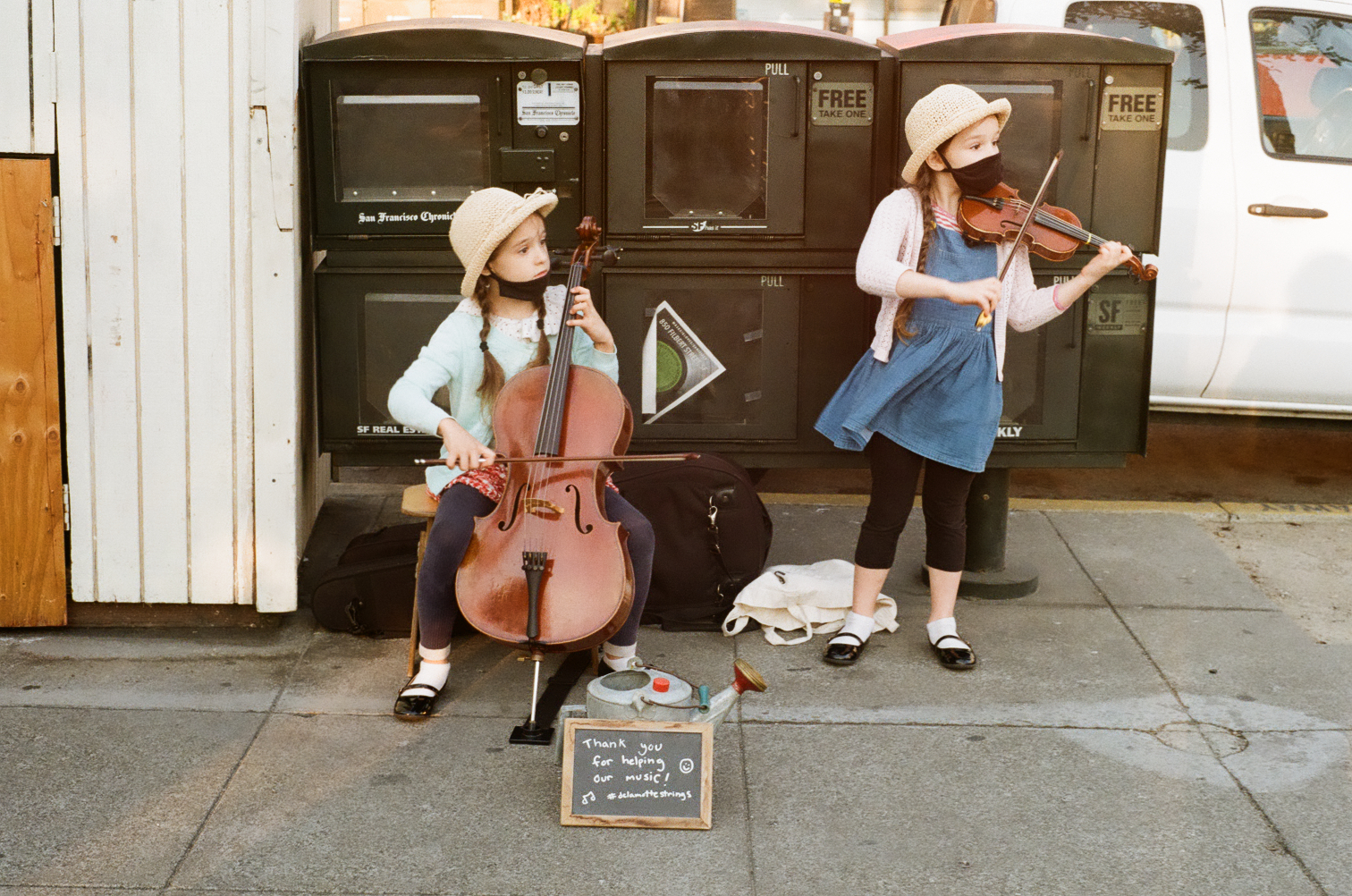
Photograph taken on a Leica M3 with 50mm Summilux, Kodacolor 200.
January 1, 2023
Finished reading: How Music Works by David Byrne 📚
David Byrne seems to like the same things I do, having written a book about bicycles, and about music. Or, I like David Byrne and the music he makes and loved seeing his thoughts on music in this book.
Part memoir (about his experience in the Talking Heads), part history and science of music, this book will be something I keep coming back to. A very helpful chapter describes the current state of the music industry and provides a cold hard glimpse into the numbers behind how professional musicians make music and money.
March 7, 2022
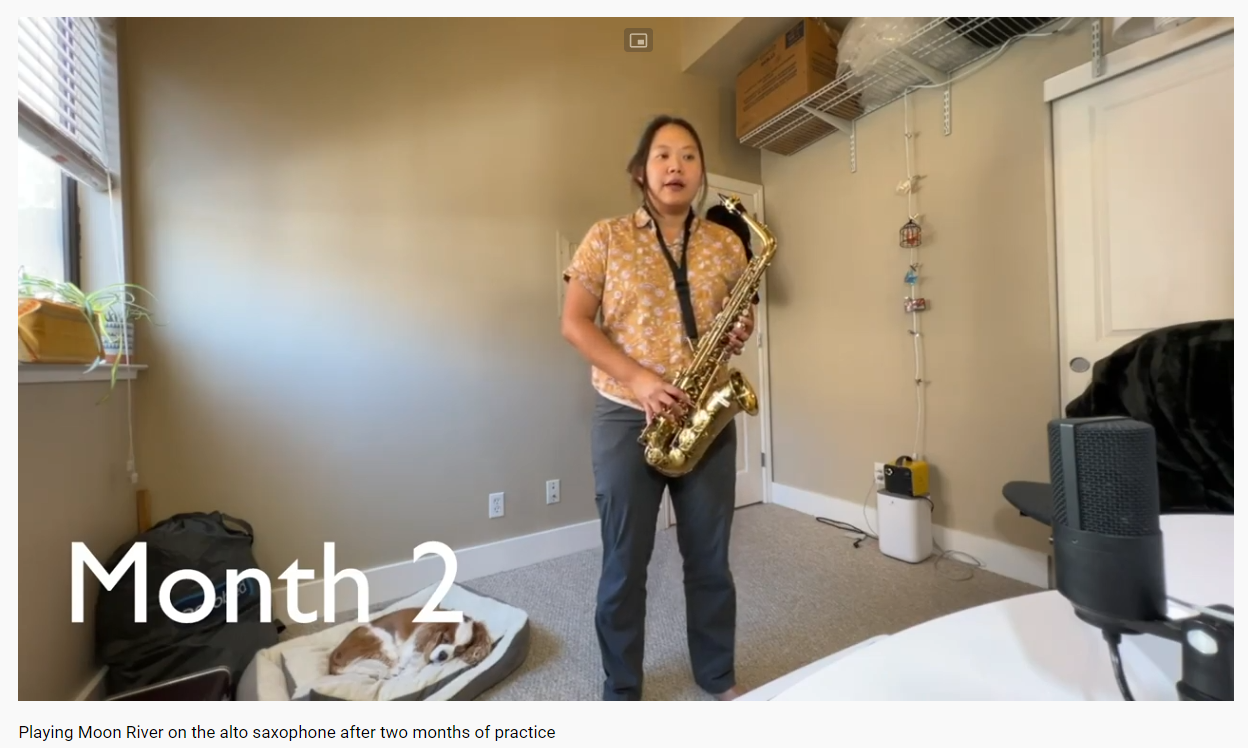
When I was a child, I immersed myself rather deeply into the world of orchestral music, especially in the woodwinds section. But the saxophone always felt too... large, for me.
I am no longer a child, so it is no longer too large. I decided to follow up on my childhood dream to play the sax (as well as every other instrument in the woodwinds section).
In January this year I began alto saxophone lessons at a music school here in San Francisco. I'm quite happy with my progress. I will need to find more time to play it more (currently playing around 2 hours a week), but in two short months I have managed to pick up enough to start playing some music.
If you're reading this and wondering if you should also learn sax, here's my advice:
- learn to read music! It really helps
- it's never too late for any of this
Many adults are somehow fearful that it's 'too late' to learn to play an instrument. It's never too late. I'm trying to adopt a beginner's mindset and to learn from scratch. Who cares if I'm any good at it? I'm having a lot of fun.
To celebrate, I started posting a bunch of videos on YouTube to chart my progress. Enjoy.
March 2, 2022
In case you have not heard, Spotify sucks. A lot.
Here's a summary of my post-Spotify exploration of music. I'm still trying to decide how I want to consume music in the future, but what I'm currently thinking about is:
- Apple Music for 'all you can eat' music streaming and music discovery
- Accompanied by Plex music library and PlexAmp on phone for music that I want to collect and keep
I'm starting to buy interesting music on Bandcamp, especially newer stuff, new music types and collaboration, things that may never get published as a CD or other record.
I'm using the SF Public Library's incredible music collection (vinyl and CD!) to borrow and listen to older music that I may have missed out on, or music that I want to listen to in higher fidelity, on different equipment.
Moving Spotify playlists to Apple Music or Tidal
#
Using services like TuneMyMusic, I was able to easily move my playlists to Apple Music and Tidal. I evaluated both services before deciding on Apple Music. Tidal did not do a good job recognizing or having access to some of my non-English music. Apple Music did not miss a beat. I'm very firmly entrenched in the Apple walled garden, so it was also a good reason to get Apple One (so everyone in my family can also have Apple Music). If you don't use iOS, you may want to evaluate other alternatives.
I decided to pony up the $5 fee on TuneMyMusic to move my music to Apple Music. It was a one-off action that took a few hours to complete. After that, I canceled my subscription as I have no need to keep my playlists in sync.
There are probably ways to do this cheaply or freely with command line tools, but I did not have time to look into it.
Buying music on Bandcamp
#
I'm lucky to be friends with many music nerds and music lovers who have carefully curated playlists and music collections. Some of them also share their favorite new music on Bandcamp.
I started buying a few albums there. I'm still finding my way around Bandcamp (it looks like I'm buying stuff that I really like, and also experimental stuff I maybe don't like as much, but find interesting enough to keep).
I don't like listening to the albums on the Bandcamp website or app, so it's handy that they let you download lossless files of the music you buy.
Setting up Plex and PlexAmp
#
Since I already had a Plex media server setup, it was simply a matter of setting up a new folder and library for music files.
I learned that the metadata from Bandcamp files isn't the best: Plex does best when you can organize files in a hierarchical Artist / Album folder structure, and for music that may not exist that way (like a lot of digital-only music on Bandcamp), Plex just doesn't pick up the music metadata neatly.
I decided to give Beets a go. The project was mature and many people swore by it. Its documentation was also excellent.
First, I had to set up the config.yaml file. Here's my config file, in case it helps.
Then, I had to install the right plugins. For my use case, the beetcamp, acousticbrainz and discogs plugins were the most useful.
I successfully re-imported all of my music files into my Plex music library like this:
beet import ~/some-path-to-music
After installing the right plugins, I was able to find matches for all of the music, including some very obscure old stuff. You can even set up the PlexUpdate plugin to let Plex know to update the music library every time music gets imported with beets.
I'm very happy with this setup, and will probably continue to grow my music collection in this way.
January 21, 2020
When we first moved to San Francisco, I was excited to have a new environment but I was not sure I would enjoy the city as much. My previous visits to the city had been mostly work/tech related. While I love many of my co-workers and friends in big tech and in startups, parts of San Francisco felt.. like a tech mono-culture.
Consciously going out to things and meeting new people, making friends with people who have interests outside of tech, through sports, volunteering or music activities, has changed my relationship to this city.
In this series of posts, I will write about the events, venues and activities I have enjoyed in San Francisco.
Music used to be a huge part of my life. From the time I was six or seven, I was in band practice or piano lessons a few times a week. Without music, my life might have turned out different. Not having much music in the last decade or so was a terrible idea, so I'm now furiously trying to get it all back. Piano lessons, jazz clarinet lessons, going to shows, meeting new friends who also like music... I have enjoyed the access to top musicians and teachers, and to excellent shows of all genres nearly every single day.
Envelop SF popped up on my radar when I was looking for music events: they were hosting a Flaming Lips listening party for Zaireeka, the band's 1997 experimental album that I'd never heard (mainly because in 1997 you needed to put 4 CDs in 4 players and press play all at once).
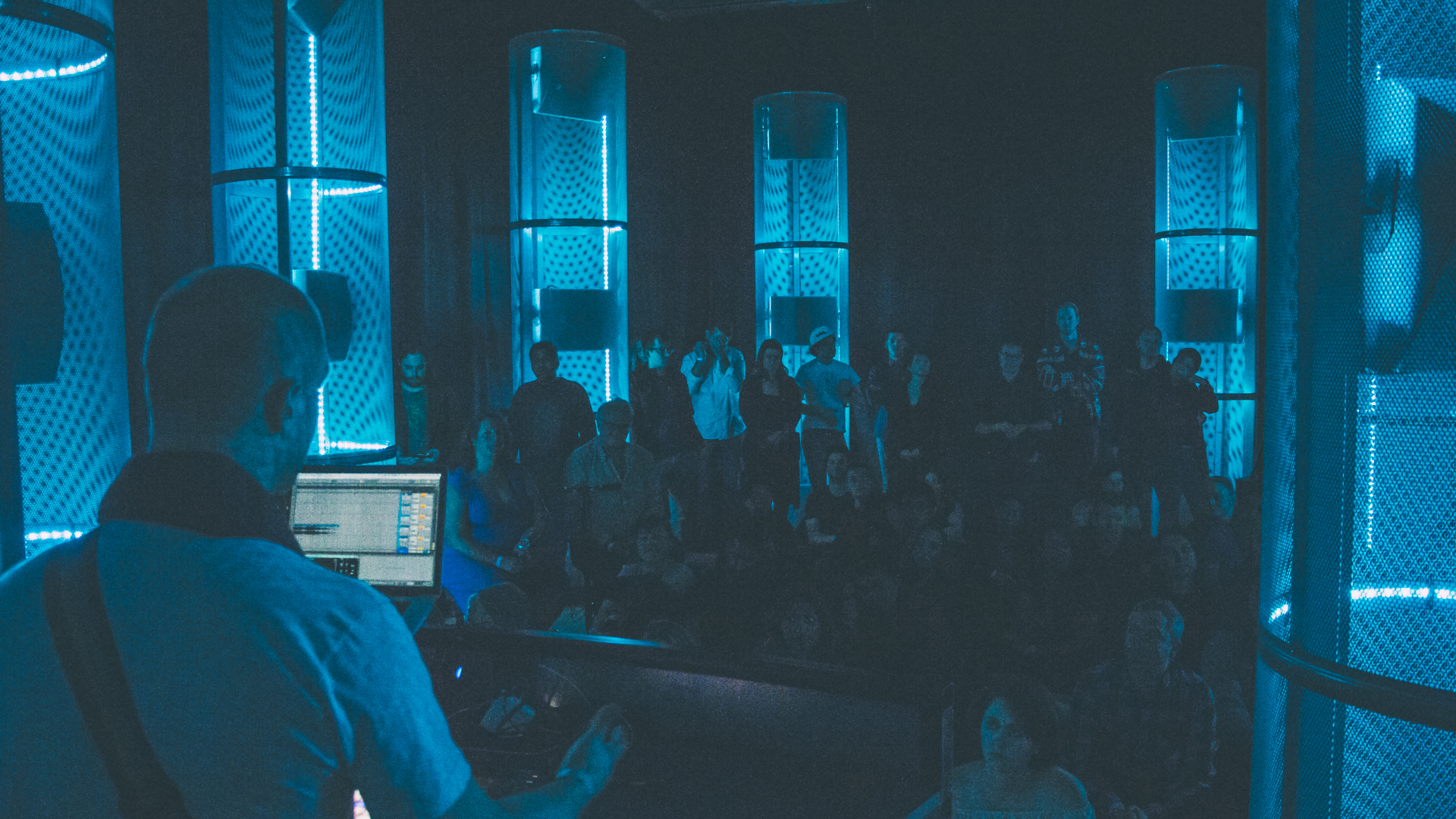 (image from Envelop)
(image from Envelop)
At first, I had no idea what these shows were. Were the Flaming Lips in town? Was it a live show? It was actually cooler than that. Envelop is a non-profit that runs an immersive audio venue in the lower Dogpatch (and another one in Salt Lake City, with popups and satellites elsewhere).
I don't know much about audio engineering or sound design, or what 'spatial music performances' are, but as I attended their session for the Flaming Lips' Zaireeka I quickly became a fan.
The venue in San Francisco is in a tiny space in an industrial area near the Dogpatch, with dim lighting, and ambience that reminded me of a yoga studio mashed up with a private DJ set. 32 speakers at the venue are positioned in a sphere, with the audience seated on foldable chairs on the floor, surrouned by said speakers. "The entire room is an instrument" was the experience they promised, and it really did feel that way. This immersive experience is powered by their open source audio software that works with Ableton Live 10.
A trust-based minibar rounded up the experience by providing for the wine, beer, tea and water you might want to sip while listening to music.
While I was initially confused by why I might want to experience 'spatial music', I came away from it a fan. I think it would be a good way for a music lover to experience music they know and love in a totally new way, with audiophile technology that would be difficult to create at home. I plan to listen to Miles Davis, Pink Floyd and Coltrane there as I think their music can be experienced differently in this environment.
Next week, jazz shows with new jazz friends. Jazz hands!
Invalid DateTime
I was just telling someone tonight: I force myself to meet a different stranger in Jakarta every single day that I'm here.
Even if I'm exhausted after work (which I usually am), I try to meet a new person, or eat a new food. Go to a new area.
The first time I lived outside of Singapore was when I moved to Dubai in 2007 right out of university. Then, without the metro or a usable public transport system, I was lost, angry and disoriented (I don't drive). I hear it's different now, but I'll never know.
Jakarta, despite the terrible traffic (and I don't think I'll ever stop saying that; I certainly haven't heard any locals stop complaining), works for me.
Between the ojek (motorbike taxi) and plentiful and good taxis, I'm pretty much covered.
I try to practise my Indonesian with total strangers, too.
Tonight's conversation went a little bit like this.
Cabbie: Why did you not get into the cab earlier! Is it because I am black?
Me: No!
Cabbie: Okay!
Me: How long have you lived in Jakarta!
Cabbie: 20 years! I'm from Timor! I play in a band! Check it out on YouTube! T-I-B-E-T B-A-N-D G-O-M-B-A-L
Me: Tay- ee- bay- aa- tay… fuck, what's this G in Indonesian?
Cabbie: Watch my videos! I'm singing! Let me put on some of my other music for you!
Me: (recognizes words like… cintamu, denganmu… JIWANG ALERT GOES UP)
Cabbie: Do you know about the galau?
Moments like these.
Rockstar cabbie in ridiculous YouTube video.
Nus Bany, is his name. He's the one in the insane costume. He also arranged and composed most of the music.
Nus Bany is now my regular taxi driver contact.
I intend to unleash him on all of my unsuspecting business visitors.
Yes, I know about the galau.
And it might be a sign that I'm moving further away from my Peninsular Southeast Asian roots when I now say galau over jiwang.
I love galau music. What's your fave?







 (image from
(image from